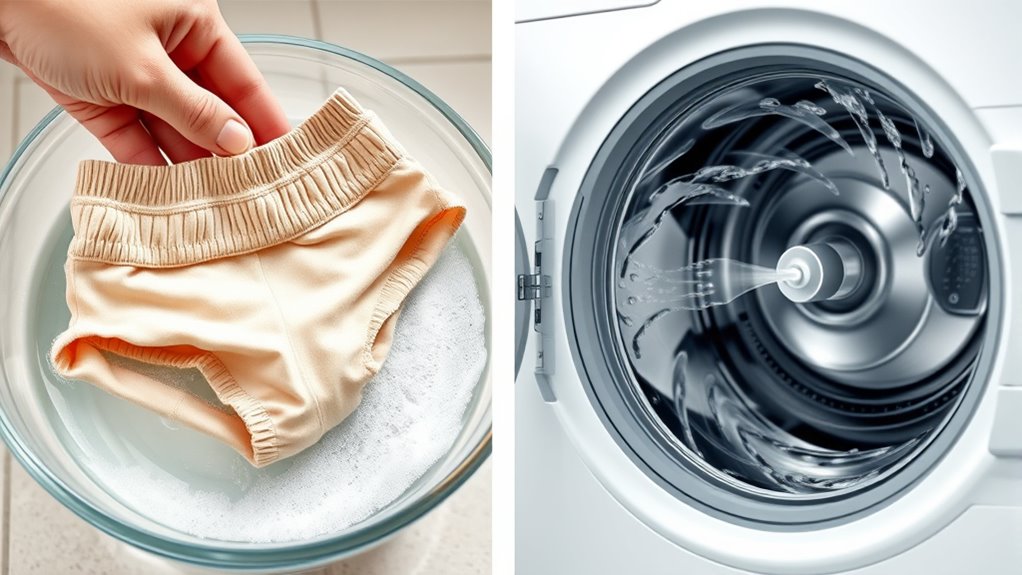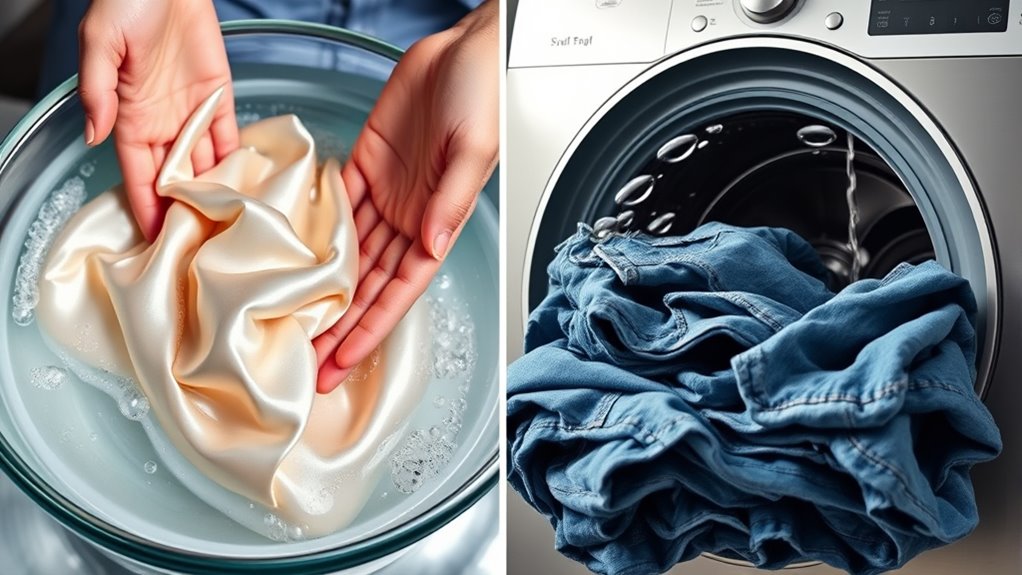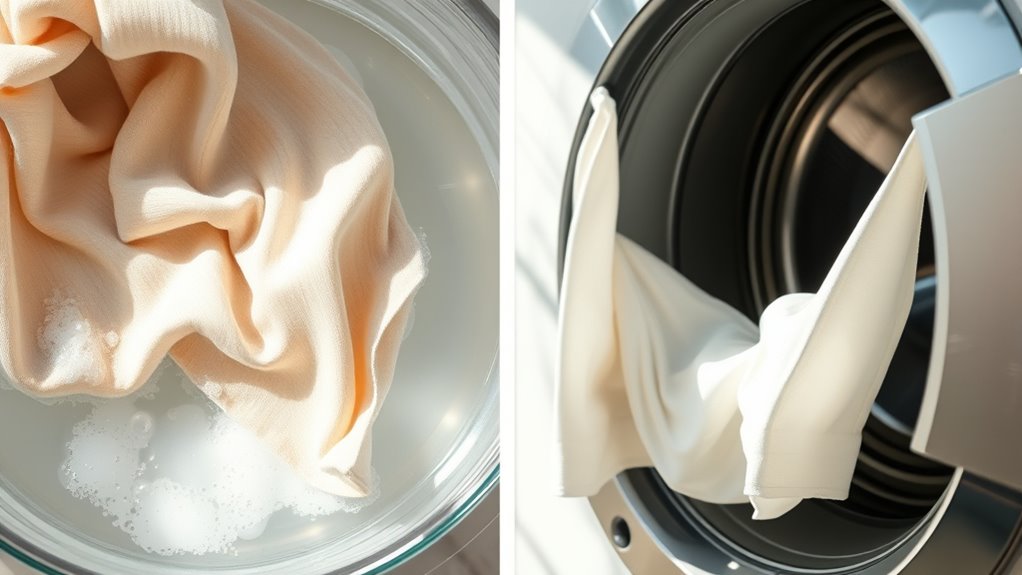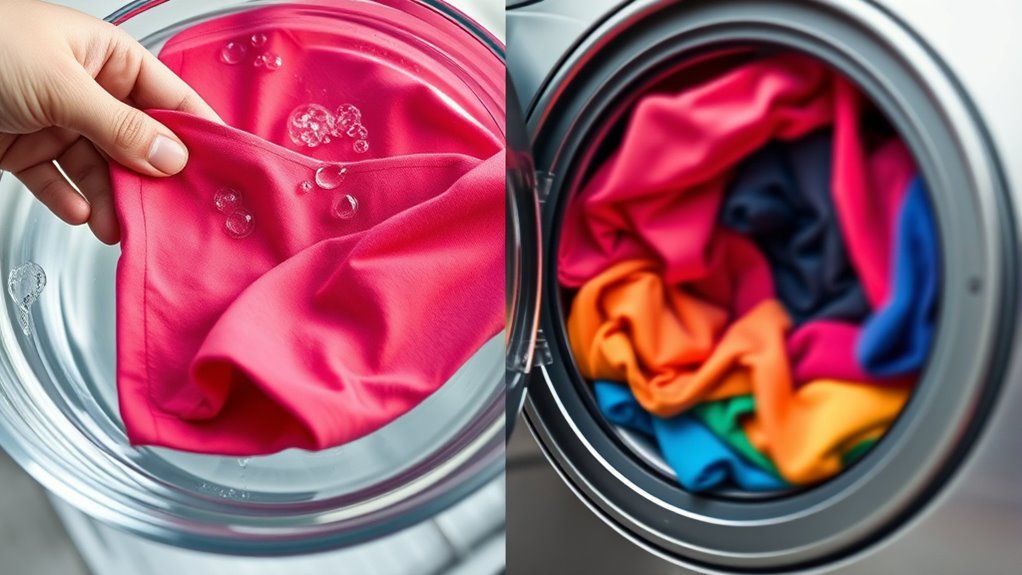Hand-washing is gentler on elastic fibers and helps preserve your garment’s stretch and shape better than machine-washing. It minimizes agitation, hot water exposure, and harsh detergents that weaken fibers over time. Using mild detergents and cool water during hand-washing can extend the lifespan of elastic fabrics. If you want to keep your clothes looking and feeling like new longer, exploring more about gentle care methods can make a big difference.
Key Takeaways
- Hand-washing minimizes agitation, reducing fiber stress and better maintaining elasticity over time.
- Gentle hand-washing prevents fiber degradation caused by high agitation in machine cycles.
- Machine-washing can damage elastic fibers if using harsh cycles or high spin speeds.
- Hand-washing allows control of water temperature, helping preserve fiber strength and shape.
- Proper hand-washing techniques extend garment lifespan by maintaining elasticity more effectively than machine-washing.
Understanding the Impact of Washing Methods on Elastic Fibers

Understanding how washing methods affect elastic fibers is essential because these fibers are what give your clothes stretch and recovery. When you wash garments aggressively, especially in a machine, fiber degradation can occur, weakening the elastic structure. Over time, this damage causes elasticity loss, making your clothes less stretchy and more prone to sagging. High agitation, hot water, and harsh detergents accelerate this degradation process. Hand-washing gently minimizes stress on the fibers, helping preserve their elasticity. Conversely, machine-washing can subject elastic fibers to repeated stress, speeding up fiber degradation. Recognizing these impacts allows you to choose washing methods that extend the lifespan of your stretchy clothes, maintaining their shape and fit longer. Proper care ensures your garments retain their original elasticity for as long as possible, especially when combined with appropriate drying techniques.
The Gentle Touch: Hand-Washing and Its Benefits for Elasticity

When it comes to preserving the elasticity of your clothes, hand-washing offers a gentle alternative to machine-washing that can considerably extend their lifespan. By choosing this delicate method, you actively support elasticity maintenance and better fabric care. Hand-washing minimizes agitation, reducing stress on fibers and preventing stretching or fraying.
Here’s why it matters:
- You preserve the fabric’s natural stretch, keeping clothes fitting like new.
- You avoid harsh detergents and high temperatures that weaken elastic fibers.
- You give your garments extra attention, ensuring they stay resilient over time.
This tender approach allows your clothes to retain their original elasticity longer, making each wear feel fresh and comfortable. Hand-washing truly nurtures fabric care, ensuring your favorite pieces last.
The Convenience of Machine-Washing: Pros and Potential Drawbacks

Machine-washing offers a quick and efficient way to clean your clothes, saving you time and effort compared to hand-washing. One advantage is the variety of detergent options, allowing you to choose formulas that suit your garments and preserve elasticity. You also have multiple washing cycle choices, from gentle to heavy-duty, giving you control over how delicate items are treated. However, this convenience can come with drawbacks. Incorrect detergent selection or harsh cycle choices may damage elastic fibers over time, reducing their stretchiness. Additionally, some fabrics may not respond well to high agitation or aggressive cycles. While machine-washing saves effort, you need to be mindful of settings and detergent types to avoid compromising your clothes’ elasticity and longevity. Proper fabric care guidelines can help maintain the elasticity of your garments over time.
Material Matters: How Different Fabrics Respond to Washing Techniques

You need to contemplate how fabrics react to washing methods. Cotton often requires gentle care to prevent shrinking or damage, while synthetic fibers are usually more durable and withstand harsher cycles. Understanding these differences helps you choose the right approach for each material. Additionally, avoiding scams and ensuring proper maintenance of your garments can extend their lifespan and preserve their elasticity.
Cotton’s Gentle Care
Cotton fabrics are known for their softness and breathability, making them a popular choice for everyday wear. To keep your cotton’s gentle qualities intact, pay attention to how you care for it.
- Use mild laundry detergents designed for delicate fabrics to prevent harsh chemicals from damaging fibers or fading vibrant colors caused by fabric dyeing.
- Wash cotton items in cold water or on a gentle cycle to protect elasticity and prevent shrinking.
- Avoid overloading the washing machine, which can cause excessive friction and wear on fibers, diminishing their softness and elasticity over time.
- Opt for gentle washing techniques, which help preserve the natural fibers and elasticity of your cotton garments.
Synthetic Fiber Resilience
Synthetic fabrics like polyester and nylon are prized for their durability and resistance to wear, making them popular choices for activewear and everyday garments. These synthetic fibers are known for their resilience, but how you wash them affects their elasticity preservation. Hand-washing gentle cycles help maintain the fibers’ elasticity longer by reducing agitation and heat exposure. Machine-washing, especially on aggressive settings, can cause synthetic fibers to lose their stretch over time, leading to sagging and deformation. To maximize resilience, use cold water and a mild detergent, and avoid high spin speeds. Proper care guarantees your synthetic garments retain their shape and elasticity longer, regardless of whether you choose hand-washing or machine-washing. Ultimately, gentle handling is key to preserving synthetic fiber resilience. Environmental considerations like reducing water and energy use can also extend the lifespan of your clothes.
Practical Tips for Preserving Elasticity in Your Garments

To keep your garments stretchy and looking new, use gentle washing techniques that minimize stress on the fabric. Make sure to dry your clothes properly, avoiding high heat that can break down elastic fibers. These simple steps can considerably extend the lifespan of your clothes’ elasticity. Additionally, choosing natural and eco-friendly cleaning methods can help maintain the integrity of elastic fibers over time, especially when using natural filtration systems to reduce chemical exposure.
Gentle Washing Techniques
When washing your garments, choosing gentle techniques can make a significant difference in maintaining their elasticity. Use mild laundry detergents that are free from harsh chemicals to protect fibers. Incorporate fabric softeners sparingly, as they help reduce stiffness and preserve stretch. Follow these practical tips:
- Wash delicate items in a mesh bag to prevent stretching and damage.
- Opt for cold or lukewarm water to avoid weakening elastic fibers.
- Gently agitate garments without wringing or twisting, which can cause deformation.
Proper Drying Methods
Proper drying methods are essential for maintaining the elasticity of your garments. To prevent damage, avoid high drying temperatures, as excessive heat can weaken fibers and cause stretching or shrinking. Instead, opt for a low or medium heat setting, or better yet, air dry when possible. Using fabric softeners during washing can help keep fibers supple, making drying more effective and gentle. When air drying, gently reshape your clothes to their original form and lay them flat or hang them on a padded hanger. Avoid wringing out garments, as this can distort their shape. By controlling drying temperature and using fabric softeners appropriately, you help preserve the elasticity and prolong the lifespan of your clothes. Understanding the weight of pinball machines can also aid in choosing the best drying and moving methods for any equipment involved in arcade settings.
When to Opt for Hand-Washing Over Machine-Washing

There are certain situations where hand-washing your clothes is the better choice, especially when dealing with delicate fabrics or items that require extra care. You should opt for hand-washing if:
- You want to control the detergent choice, avoiding harsh chemicals that could damage sensitive fibers.
- The fabric is fragile, like lace or silk, which can be harmed by the tumbling action of a machine.
- You need to carefully manage water temperature, using lukewarm or cold water to prevent stretching or shrinking.
- Hand-washing is particularly recommended for garments made of delicate fabrics to help maintain their elasticity and appearance.
Hand-washing allows you to gently clean your clothes without risking elasticity loss. It’s especially vital for delicate or elastic items that demand gentle handling to preserve their stretch and shape.
Expert Recommendations for Extending the Life of Elastic Clothing

To keep your elastic clothing looking and feeling its best, following expert recommendations can make a significant difference. Use eco-friendly detergents to gently clean without damaging fibers. Always control the water temperature; cold or lukewarm water helps preserve elasticity. Avoid hot water, which can weaken elastic fibers over time. Additionally, air-dry your clothing instead of using a dryer, as heat accelerates deterioration. Incorporating trendy dog sweaters into your wardrobe can also help you stay stylish during colder months.
Frequently Asked Questions
How Does the Temperature of Water Affect Fabric Elasticity?
You might notice that water temperature impacts fabric elasticity profoundly. Hot water can weaken fibers, causing them to lose stretch and snap. Cold water helps preserve fabric elasticity, keeping your clothes more resilient and maintaining their original shape. Always check your garment care labels, but generally, using cold or lukewarm water is better for maintaining elasticity, preventing damage, and extending the lifespan of your clothes.
Can Using Fabric Softeners Damage Elastic Fibers?
Imagine your elastic fibers as tiny springs, delicate yet essential. Fabric softener damage can cause these springs to weaken over time, leading to elastic fiber deterioration. Though softeners make clothes feel smooth, they can coat fibers, reducing stretch and elasticity. You should be cautious, as frequent use may accelerate damage, compromising your garments’ flexibility. Opt for gentle washing methods to preserve the integrity of your elastic fibers and extend their lifespan.
Is Air-Drying Better Than Tumble Drying for Elasticity Preservation?
You might find air drying better than tumble drying for preserving elasticity because air drying offers gentle care, reducing stress on fibers and preventing damage. Tumble drying risks include heat and tumbling action that can weaken elastic fibers over time. By air drying, you maintain your garments’ stretchiness and longevity, avoiding the potential shrinkage or loss of elasticity that comes with high heat and mechanical agitation from tumble dryers.
Do Specific Detergents Help Maintain the Stretch of Elastic Fabrics?
You should choose detergents formulated for fiber preservation, as they help maintain the stretch of elastic fabrics. These specialized detergent formulations are gentle yet effective, reducing fiber damage and keeping elasticity intact over time. When shopping, look for products designed to protect delicate fibers, ensuring your elastic garments stay flexible and comfortable longer. Proper detergent choice directly impacts the longevity and performance of your stretchy clothing.
How Often Should Elastic Clothing Be Washed to Prevent Damage?
To prevent damage, you should follow these washing frequency tips for elastic clothing: wash only when necessary, typically after 3-4 wears, and avoid excessive washing. Over-washing can weaken the elasticity, so use gentle cycles or hand-wash when possible. Always check care labels for specific instructions. By maintaining a proper washing frequency, you help preserve the fabric’s stretch and prolong the lifespan of your elastic garments.
Conclusion
To keep your elastic garments springy and fresh, think of hand-washing as giving them a gentle hug—tender and careful. While machines offer convenience, they can sometimes be a rough ride for delicate fibers. By choosing the right method and following expert tips, you’ll extend the life of your favorite pieces and keep them bouncing back like a rubber ball. Treat your clothes with care, and they’ll reward you with lasting stretch and comfort.









